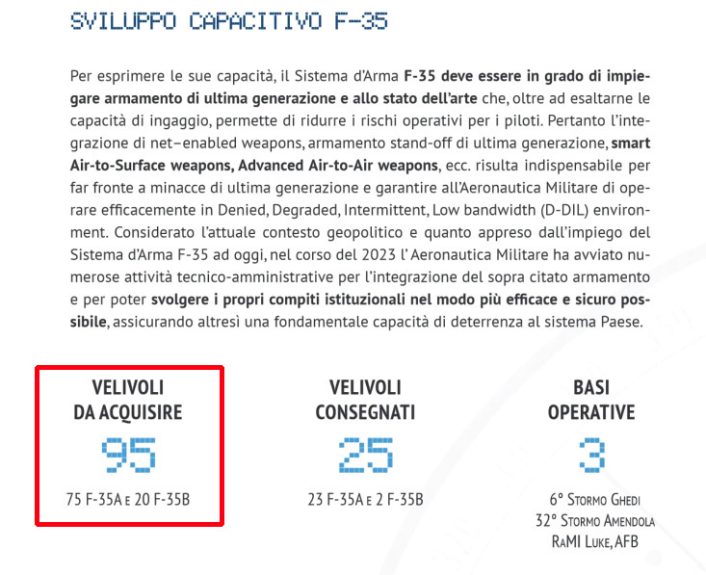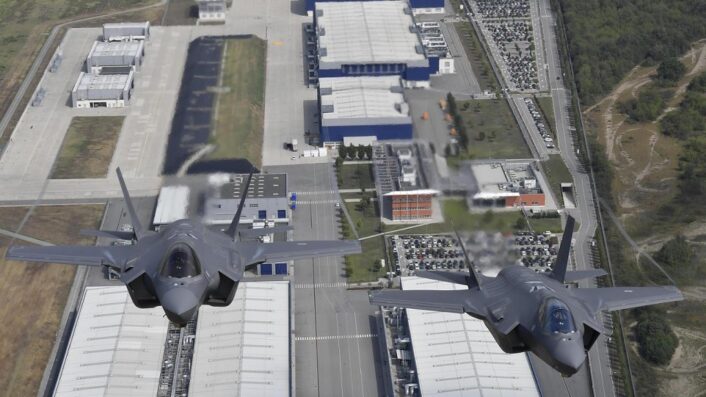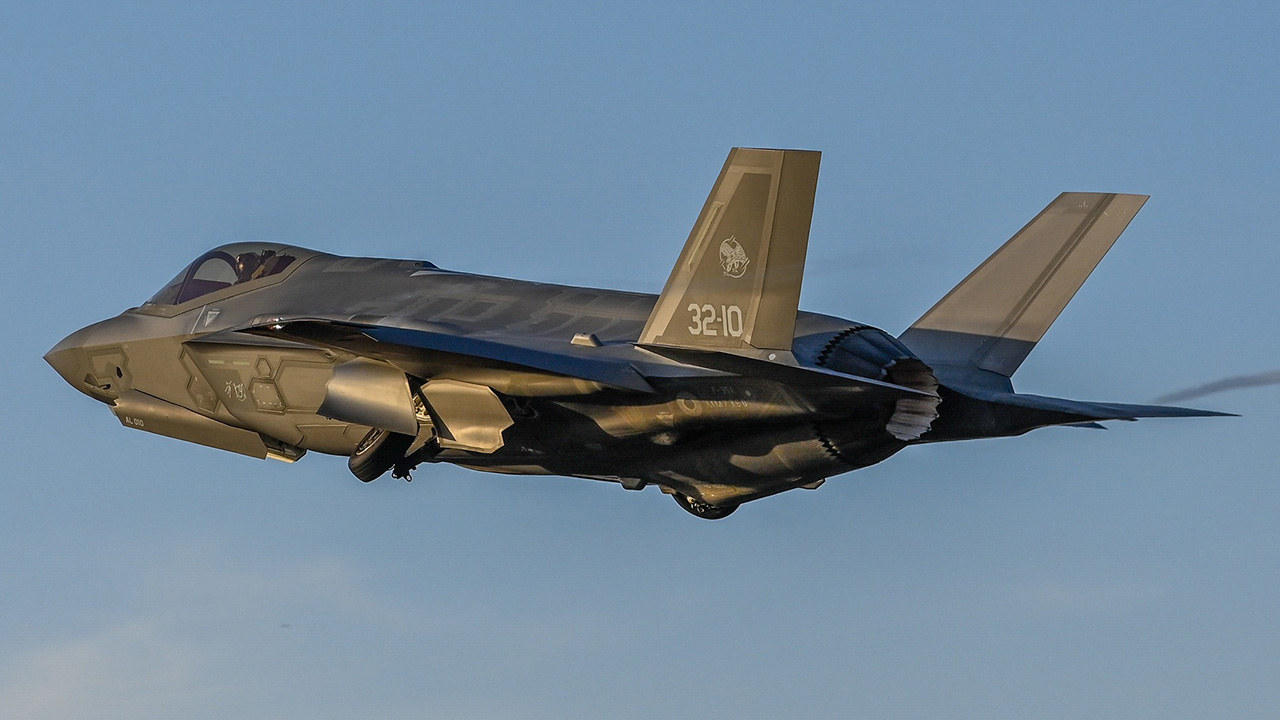The Italian Air Force has emphasized since last year that it requires more F-35A and F-35B jets. Public data indicates that it may eventually acquire 20 additional Lightning II aircraft.
Last year, the Italian Air Force’s Chief of Staff Gen. Luca Goretti, highlighted the need to restore the original quota of 131 jets, as part of the guidelines to maintain and increase the efficiency, effectiveness and relevance of the Italian Air Force in Italy and the rest of the world.
“The Italian Air Force has always believed that the F-35 aircraft is the most advanced weapon system available today, crucial to continue to guarantee capabilities that are irreplaceable for an Air Force that aspires to be strategically relevant and operationally decisive, not only in carrying out the daily national Air Defense mission, but especially to operate in conflict scenarios where we might be called upon to counter a well-equipped and heavily armed opponent determined to impose itself by any means possible,” Goretti said on Mar. 8, 2023, during a hearing at the Defense Commission of the Camera dei Deputati (lower house of Italian parliament).
To achieve air superiority in future scenarios, the Italian Air Force has requested a reversal of past decisions, aiming to rapidly restore the F-35 and Eurofighter fleets to at least the number of aircraft that had been carefully studied before 2012.

Dealing with the Eurofighter, Italy has now a plan to buy 24 new Typhoons; for what concerns the F-35, data included in a recent annual review published on the Italian Air Force’s website seems to suggest a future expansion of the current F-35 Lightning II fleet by 20 aircraft.
As a Level 2 partner in the F-35 program, Rome initially planned to acquire 131 aircraft to replace the aging and costly AMX and Tornado fleets of the Italian Air Force, as well as the AV-8B+ Harrier jump jets of the Italian Navy. However, the number was reduced by 30 percent, from 131 to 90, due to the economic situation rather than military analysis, as noted by Goretti. The current plan, based on the 2012 cuts, involves procuring a total of 90 F-35s: 60 F-35As and 30 F-35Bs, with the latter split evenly between the Navy and the Air Force, each receiving 15. Goretti emphasized that reaching the original goal of 131 aircraft by 2030 remains a priority.
According to the latest report (which also provided details about the planned negotiations for the 24 additional Eurofighters), the Italian Air Force aims to expand its fleet to 75 F-35A and 20 F-35B aircraft, an increase from the originally planned 60 F-35A and 15 F-35B—a total boost of 20 aircraft (15 A models and 5 B models). While no new orders or negotiations have been announced, this is the first time such figures, whether as plans or requirements, have been made public.

Currently, there is no update on a potential increase in the F-35B order for the Italian Navy, which is slated to receive 15 aircraft. However, the Air Force’s increased acquisition of F-35Bs could potentially lead to a revision of the Navy’s order, possibly raising it to 20 units as well.
The current Lightning’s fleet situation
With the first aircraft received in 2015, the Italian Air Force has so far received 24 F-35A and 2 F-35B aircraft, which are stationed across three different bases in Italy and the United States. The F-35A aircraft are assigned to Ghedi Air Base and Amendola Air Base in Italy, as well as Luke Air Force Base in Arizona, U.S., where the 156° Gruppo (Squadron) has recently been reactivated. The F-35B aircraft are currently operating from Amendola under the 13th Squadron and the CSAS (Centro Supporto Addestramento e Standardizzazione -Training and Standardization Support Center), in coordination with the Italian Navy component, which is operating an additional 6 F-35B aircraft.
In 2024, the Italian Air Force has received only one aircraft, likely due to delays associated with the TR-3 software upgrade. Lockheed Martin recently announced the delivery of the first TR-3 equipped aircraft, suggesting that deliveries of the Italian Air Force and Navy will soon be resumed . This development indicates a positive step towards overcoming the recent delays and continuing the enhancement of Italy’s F-35 Fleet.
The assembly line of Cameri AB
Cameri, located in northern Italy, hosts Europe’s only assembly line for the F-35 aircraft. This facility, spread over 500,000 square meters, is known as the Final Assembly and Check Out (FACO) site and has been designated as the production line for F-35 aircraft not only for Italy, but also for several other countries including the Netherlands, Czech Republic, and Switzerland.
The Cameri FACO, managed by Leonardo in collaboration with Lockheed Martin, plays a crucial role in the production and maintenance of these advanced fighter jets, contributing significantly to the broader F-35 program. Alongside the final assembly of the aircraft, Cameri hosts a dedicated complex for the assembly of the wings and part of the fuselage of the aircraft, enhancing its role in the overall production process.

Cameri is not only an assembly facility. Thanks to its MROU (Maintenance, Repair, Overhaul, and Upgrade) component, which became operational with the declaration of Initial Operational Capability (IOC) in 2019, it is currently the only facility in Europe capable of supporting major maintenance events and upgrading F-35s. Since July 2022, the MROU at Cameri has been providing maintenance and upgrade services to European F-35s.
Before it is delivered to the “customer”, an F-35 must undergo a series of rigorous tests to ensure its efficiency and readiness for service. These tests, carried out at Cameri, are designed to evaluate the aircraft’s performance, systems integration, and overall airworthiness.
Depending on the variant of the F-35, the testing process can involve between four to six flights, conducted by pilots from both Lockheed Martin and the Defense Contract Management Agency (DCMA). Only at the end of this standardized process the customer can take over its aircraft for the delivery to the assigned squadron.
Current Operational Bases and Future Candidates
As mentioned, the Italian Air Force operates its F-35s from two main bases in Italy: Ghedi Air Base in northern Italy and Amendola Air Base in Apulia, southeastern Italy. Ghedi is poised to become the first in Italy to host a nuclear-capable squadron of F-35s, highlighting its strategic importance and advanced operational role; Amendola Air Base not only supports F-35 operations but also plays a crucial role in national airspace defense through its Quick Reaction Alert (QRA) cell, ensuring a rapid response to potential aerial threats.
During the centennial celebration of the Italian Air Force, Lockheed Martin presented a vision of a possible future base for the F-35 at Decimomannu Air Base, currently home to the International Flight Training School (IFTS). It remains uncertain whether Decimomannu will host a new squadron or serve as a potential relocation site for the newly reopened 156th Squadron, which currently serves as an Operational Conversion Unit at Luke AFB in the US.
As demonstrated by the ongoing conflict in Ukraine, dispersing military assets across a broader geographic area can offer a tactical advantage against potential threats. Last but not least the Italian Air Force, thanks to the collaboration with the Italian Navy, is currently able to operate the F-35B from the ITS Cavour aircraft carrier, giving an unmatched capability to the Air Force by increasing the force projection opportunities.














